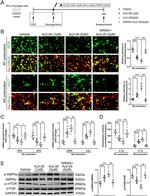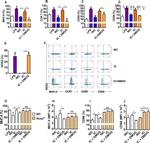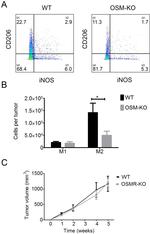Search Thermo Fisher Scientific
Invitrogen
iNOS Monoclonal Antibody (CXNFT), eFluor™ 450, eBioscience™
FIGURE: 1 / 17
iNOS Antibody (48-5920-82) in Flow

















Product Details
48-5920-82
Species Reactivity
Published species
Host/Isotype
Recommended Isotype Control
Class
Type
Clone
Conjugate
Excitation/Emission Max
Form
Concentration
Purification
Storage buffer
Contains
Storage conditions
Shipping conditions
RRID
Product Specific Information
Description: This CXNFT monoclonal antibody reacts to mouse NOS2 (inducible NOS, iNOS). Nitric oxide synthase enzymes catalyze the formation of nitric oxide from L-arginine through an NADPH- and oxygen-dependent mechanism. There are three isoforms of NOS that are encoded by three separate genes. NOS1 (neuronal NOS, nNOS) and NOS3 (endothelial NOS, eNOS) are constitutively expressed, while NOS2 is induced in response to bacterial endotoxins and inflammatory cytokines such as IFN gamma and TNF alpha. NOS2 is expressed by myeloid-derived suppressor cells and M1 macrophages but not alternatively activated M2 macrophages. NOS enzymes are functionally active only when they form homodimers, and dimerization of NOS2 occurs at steady-state concentrations of free Ca2+ such that NOS2 is functionally active when it is produced.
Applications Reported: This CXNFT antibody has been reported for use in flow cytometric analysis.
Applications Tested: This CXNFT antibody has been tested by flow cytometric analysis of thioglycolate-elicited peritoneal macrophages using the Intracellular Fixation & Permeabilization Buffer Set (Product # 88-8824-00) and protocol. Please refer to "Staining Intracellular Antigens for Flow Cytometry, Protocol A: Two step protocol for intracellular (cytoplasmic) proteins" located at thermofisher.com. This may be used at less than or equal to 1.0 µg per test. A test is defined as the amount (µg) of antibody that will stain a cell sample in a final volume of 100 µL. Cell number should be determined empirically but can range from 10^5 to 10^8 cells/test. It is recommended that the antibody be carefully titrated for optimal performance in the assay of interest.
eFluor 450 is an alternative to Pacific Blue. eFluor 450 emits at 446 nm and is excited with the violet laser line (405 nm). Please make sure that your instrument is capable of detecting this fluorochrome.
Excitation: 405 nm; Emission: 445 nm; Laser: Violet Laser.
Target Information
iNOS (Inducible Nitric oxide, NO, NOS) is an inorganic, gaseous free radical that carries a variety of messages between cells. Vasorelaxation, neurotransmission and cytotoxicity can all be potentiated through cellular response to NO. NO production is mediated by members of the nitric oxide synthase (NOS) family. iNOS is expressed in liver and inducible by a combination of lipopolysaccharide and certain cytokines. NOS catalyzes the oxidization of L-arginine to produce L-citrulline and NO. Two constitutive isoforms, brain or neuronal NOS (b or nNOS, type I) and endothelial cell NOS (eNOS, type III), and one inducible isoform (iNOS, type II), have been cloned. All NOS isoforms contain calmodulin, nicotinamide adenine dinucleotide phosphate (NADPH), flavin adenine dinucleotide (FAD), and flavin mononucleotide (FMN) binding domains. iNOS is found in a variety of cell types including macrophages, hepatocytes, synoviocytes, and smooth muscle cells. Cytokines such as interferon-gamma (IFN), tumor necrosis factor (TNF), interleukin-1 and -2, and lipopolysaccarides (LPS) cause an increase in iNOS mRNA, protein, and activity levels. Protein kinase C-stimulating agents exhibit the same effect on iNOS activity. After cytokine induction, iNOS exhibits a delayed activity response which is then followed by a significant increase in NO production over a long period of time. Three related iNOS pseudogenes are located within the Smith-Magenis syndrome region on chromosome 17. Diseases associated with iNOS dysfunction include achalasia and impotence.
For Research Use Only. Not for use in diagnostic procedures. Not for resale without express authorization.
Bioinformatics
Protein Aliases: hepatocytes; inducible nitric oxide synthase; Inducible NO synthase; Inducible NOS; MAC-NOS; Macrophage NOS; nitric oxide synthase 2, inducible, macrophage; Nitric oxide synthase, inducible; nitric oxide synthase-inducible; NOS type II; OTTMUSP00000000202; Peptidyl-cysteine S-nitrosylase NOS2
Gene Aliases: i-NOS; iNOS; Inosl; Nos-2; NOS-II; Nos2; Nos2a
UniProt ID: (Mouse) P29477
Entrez Gene ID: (Mouse) 18126

Performance Guarantee
If an Invitrogen™ antibody doesn't perform as described on our website or datasheet,we'll replace the product at no cost to you, or provide you with a credit for a future purchase.*
Learn more
We're here to help
Get expert recommendations for common problems or connect directly with an on staff expert for technical assistance related to applications, equipment and general product use.
Contact tech support

